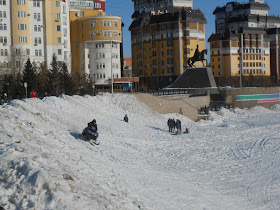Just last week the excellent Your Expat Child blog posted a guest article that I wrote on how to
prepare for and cope when things go wrong. When I wrote that piece I was thinking about all the back ups we have in
place as a family to deal with such situations.
I did not realise that, just a few days later, I would find myself being
sent to Europe for an emergency operation.
I had been feeling a little unwell last week and so made an
appointment with our GP. He went with me
to one of the local hospitals in Astana for some tests. This is a new system for us – previously we
had no English speaking GP or translation support. I was very pleased he was with me as it made
the whole process much simpler. I do
understand enough Russian to get by in day to day life but answering questions
and understanding what a Doctor is saying to you about complex medical issues is
very different.
The tests showed that I had been unwell for some weeks, just
unaware of it, and the hospital wanted me to have an operation straight
away. Our insurers have not had any
experience of the hospitals that could do the operation or, they told me, any
experience of operations in Astana full stop.
They said they would be more comfortable with me travelling to Frankfurt
or Istanbul to have it done. The next
available flight was to Frankfurt so I ended up packing a bag for a trip to
Germany.
I must admit that I was in two minds about which destination
I would prefer. In many ways I wanted to
have things done in Astana with my family around but I also believe in
listening to the professionals. I have
friends in Istanbul from our time living in Turkey and know no-one in Frankfurt
but despite never having lived there I speak better German than I do Turkish. I think, in the end, either destination would
have been fine.
In a way the medevac process itself was rather
underwhelming. I remember when I lived
in Nigeria practically every flight out of the country had someone on a stretcher
in the back of the aircraft – not dissimilar to the set up for the little girl
in the spoof movie ‘Airplane’. Luckily
this did not happen to me; because I was well enough to travel alone and
without a nurse it was no different to a normal flight. When I arrived I took a taxi to the hospital,
checked in and was treated the next day.
I had hoped to travel home the same day but apparently you are not
allowed to travel for 24 hours after a general anaesthetic. Looking back that was probably the right
decision – I flew home on Sunday night arriving Monday morning and despite
being someone who is never ill, travels well and needs hardly any sleep I found
the journey much harder than I expected.
In hindsight the whole event seems like a bit of a dream but
it has started me thinking about what really helped make it less
unpleasant. All our emergency planning
and the procedures we have in place worked flawlessly which was wonderful. The main thing that helped was that I really
trusted the insurers and their co-ordinators to make the best choices for me, they updated me on their decisions as quickly as possible and were very open and thorough when discussing them with me.
I had an internet enabled ‘phone I could
use to contact friends and family. When
we left the UK we were in two minds about whether to keep our monthly ‘phones
or to use pay as you go sims when we returned.
We decided to keep our ‘phones; we get good rates on international calls
and internet roaming. Because they are
contracts we don’t need to worry about getting cut off. Our Kazakh phones are pay as you go so
although they work abroad we cannot re-charge them when the credit runs out. The UK ‘phones may be an expensive luxury 11
months of the year but I would not have been without it this last weekend.
I was very glad that I took my computer and my kindle with
me. I did not get any work done at all
but I was able to watch films on the laptop.
German and Turkish television tends to be dubbed rather than subtitled
and for a lot of the time I just felt like zoning out in front of some rubbish
TV without having to make a mental effort to understand what people were saying. The kindle meant that I did not need to worry
about packing enough books for an open ended stay.
One thing that, in retrospect, I did wrong was not drinking
something before I left the airport.
Because I had been feeling unwell I had not eaten a proper meal in
days. I took some water on the flight
with me but I should have had some more in Frankfurt before going to the
hospital. As soon as I arrived there I was
nil by mouth until after the operation.
I didn't feel like eating but I was horribly dehydrated and
thirsty.
It was certainly not an experience I wanted to have and it
is not one that I want to repeat. That
said it is a comfort to know that the whole process works and that our family
are in safe hands in the event of any emergency.
Click on the picture for more posts on the challenges of expat life.
Click on the picture for more posts on the challenges of expat life.





































